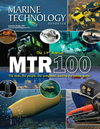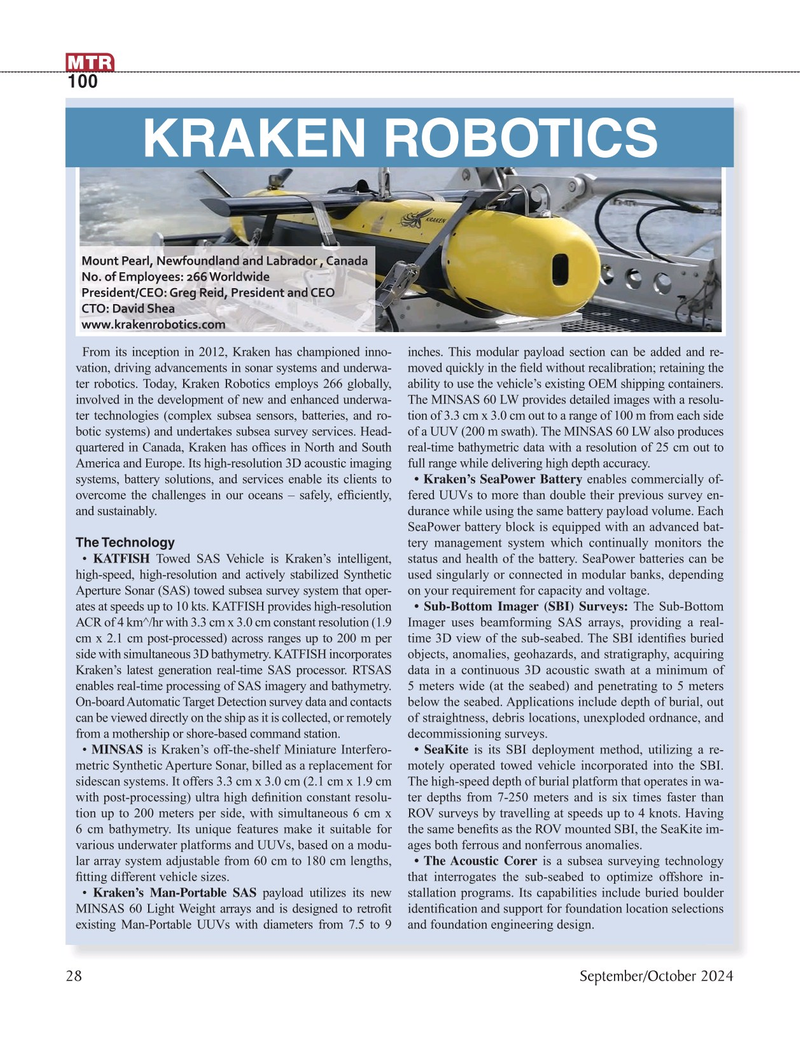
Page 28: of Marine Technology Magazine (September 2024)
Read this page in Pdf, Flash or Html5 edition of September 2024 Marine Technology Magazine
MTR 100
KRAKEN ROBOTICS
Mount Pearl, Newfoundland and Labrador , Canada
No. of Employees: 266 Worldwide
President/CEO: Greg Reid, President and CEO
CTO: David Shea www.krakenrobotics.com
From its inception in 2012, Kraken has championed inno- inches. This modular payload section can be added and re- vation, driving advancements in sonar systems and underwa- moved quickly in the ? eld without recalibration; retaining the ter robotics. Today, Kraken Robotics employs 266 globally, ability to use the vehicle’s existing OEM shipping containers. involved in the development of new and enhanced underwa- The MINSAS 60 LW provides detailed images with a resolu- ter technologies (complex subsea sensors, batteries, and ro- tion of 3.3 cm x 3.0 cm out to a range of 100 m from each side botic systems) and undertakes subsea survey services. Head- of a UUV (200 m swath). The MINSAS 60 LW also produces quartered in Canada, Kraken has of? ces in North and South real-time bathymetric data with a resolution of 25 cm out to
America and Europe. Its high-resolution 3D acoustic imaging full range while delivering high depth accuracy. systems, battery solutions, and services enable its clients to • Kraken’s SeaPower Battery enables commercially of- overcome the challenges in our oceans – safely, ef? ciently, fered UUVs to more than double their previous survey en- and sustainably. durance while using the same battery payload volume. Each
SeaPower battery block is equipped with an advanced bat-
The Technology tery management system which continually monitors the • KATFISH Towed SAS Vehicle is Kraken’s intelligent, status and health of the battery. SeaPower batteries can be high-speed, high-resolution and actively stabilized Synthetic used singularly or connected in modular banks, depending
Aperture Sonar (SAS) towed subsea survey system that oper- on your requirement for capacity and voltage.
ates at speeds up to 10 kts. KATFISH provides high-resolution • Sub-Bottom Imager (SBI) Surveys: The Sub-Bottom
ACR of 4 km^/hr with 3.3 cm x 3.0 cm constant resolution (1.9 Imager uses beamforming SAS arrays, providing a real- cm x 2.1 cm post-processed) across ranges up to 200 m per time 3D view of the sub-seabed. The SBI identi? es buried side with simultaneous 3D bathymetry. KATFISH incorporates objects, anomalies, geohazards, and stratigraphy, acquiring
Kraken’s latest generation real-time SAS processor. RTSAS data in a continuous 3D acoustic swath at a minimum of enables real-time processing of SAS imagery and bathymetry. 5 meters wide (at the seabed) and penetrating to 5 meters
On-board Automatic Target Detection survey data and contacts below the seabed. Applications include depth of burial, out can be viewed directly on the ship as it is collected, or remotely of straightness, debris locations, unexploded ordnance, and from a mothership or shore-based command station. decommissioning surveys. • MINSAS is Kraken’s off-the-shelf Miniature Interfero- • SeaKite is its SBI deployment method, utilizing a re- metric Synthetic Aperture Sonar, billed as a replacement for motely operated towed vehicle incorporated into the SBI. sidescan systems. It offers 3.3 cm x 3.0 cm (2.1 cm x 1.9 cm The high-speed depth of burial platform that operates in wa- with post-processing) ultra high de? nition constant resolu- ter depths from 7-250 meters and is six times faster than tion up to 200 meters per side, with simultaneous 6 cm x ROV surveys by travelling at speeds up to 4 knots. Having 6 cm bathymetry. Its unique features make it suitable for the same bene? ts as the ROV mounted SBI, the SeaKite im- various underwater platforms and UUVs, based on a modu- ages both ferrous and nonferrous anomalies.
lar array system adjustable from 60 cm to 180 cm lengths, • The Acoustic Corer is a subsea surveying technology ? tting different vehicle sizes. that interrogates the sub-seabed to optimize offshore in- • Kraken’s Man-Portable SAS payload utilizes its new stallation programs. Its capabilities include buried boulder
MINSAS 60 Light Weight arrays and is designed to retro? t identi? cation and support for foundation location selections existing Man-Portable UUVs with diameters from 7.5 to 9 and foundation engineering design. 28 September/October 2024
MTR #7 (18-33).indd 28 10/3/2024 11:33:01 AM

 27
27

 29
29
